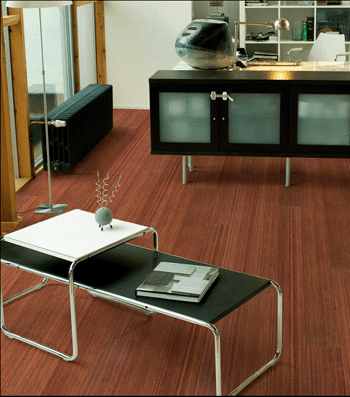 |
| Natural Cork’s pecan bamboo. |
|
By Louis Iannaco
The bamboo flooring segment has skyrocketed in popularity in recent years due to the trend of bringing nature indoors as well as its environmentally friendly benefits.
With advances in technology, mills are now able to provide different looks, which are attracting retailers and consumers alike in the common desire to beautify the home and create a more natural lifestyle. Whether it’s home or office, residential or commercial, the choices afforded are no longer dominated by the light, natural toned bamboo shade. Mills are doing more research on what the shopper wants.
According to Ann Knight, executive vice president/marketing director for Teragren, the company monitors the market to determine what consumers are looking for. “Before developing a product, we look for trends in the apparel and building industries, and poll architects, designers and builders. We consider flooring a fashion item.”
Teragren also works closely with its factory partner in Asia before launching any product. Once one is ready, the mill performs independent testing by a U.S. laboratory to ensure it meets U.S. building standards and codes. Recently, the company unveiled its Synergy strand flooring line. Created through a patented process, the line is much harder than red oak, according to Knight. Available in wheat, chestnut and java colors, it is manufactured according to stringent U.S. and European environmental standards.
Before Synergy, Teragren debuted its Signature Colors bamboo line, available in expresso, cherry, walnut and charcoal machine-stained colors. “We developed the stain colors based on feedback from the trade to offer the option of matching our flooring to other types of hardwoods used in cabinetry and furniture,” she said.
Flat grain natural planks are stained and coated with a water-based, solvent-free, five-coat aluminum oxide finish, added Knight, with two topcoats of scratch-resistant polyurethane for easy care and durability.
At this year’s Surfaces, Natural Cork unveiled its latest collection of engineered bamboo flooring. It consists of 13 SKUs; five rich wood tone colors—ebony, chestnut, hickory, pecan and porto—on a smooth surface of vertical grain bamboo, as well as the same colors repeated on hand sculpted boards. The other three SKUs are made of strand woven bamboo; light color, caramelized and a blend of both light and dark strips resembling tigerwood.
Strand woven bamboo is made of pressed bamboo strips. This high-density material is extremely hard, noted Natural Cork’s CEO, Philippe Erramuzpe, and can be recommended for high-traffic areas. “This product is very good looking and should become quite popular.” The traditional two-toned bamboo in 3-foot length has achieved commodity status, and as pricing has come down, low-priced products are now available all over.
“Unfortunately,” he noted, “many of these are substandard, and end users become dissatisfied with their purchase. We felt for the specialty retailer to be in the bamboo flooring business, he needed to offer a unique selection with choices in styles and colors to accommodate different décor schemes.” Also, by offering an engineered construction, it can be nailed, glued down, floated and isolated from the subfloor to prevent contact with moisture, he added.
Duro-Design Cork & Bamboo Flooring offers 54 bamboo colors made with light fast pigments, dyers and alcohols/water stains. “Six coats of our MP675 water base urethane is applied on top of the stains,” said Lawrence Fiorentini, marketing manager. He noted, no aluminum oxide is used, so refinishing is quite easy. “Our bamboo is doing very well commercially and residentially, mainly because we are the only ones to offer it in such a variety of colors.”
GreenWood Products first started pre-staining bamboo in late 2002. By the third quarter of 2003, the mill began the production of its Designer Tones line of pre-stained bamboo flooring. Realizing the difference in hardness between the carbonized (walnut) and natural (red oak) colors, GreenWood stayed away from colors that could not be made with the underlying natural base, said owner Rick Paxton.
“Though either product is fine for residential applications, GreenWood was also seeking commercial business and wanted to maintain as hard a surface as possible,” he explained.
GreenWood sees enough demand for handscraped products to offer its customers one in bamboo. “Since the introduction of these lines, there’s been the usual tweaking of colors,” Paxton said. “We’re currently looking at a new engineered bamboo made outside of China, which utilizes a reclaimed hardwood as the core and will have a 4mm bamboo wear layer. It will be stained and aimed primarily at the commercial market.”
Commercial business has been centered on GreenWood’s Designer Tones line. “We’re seeing more specifications nationally as well as increased interest from specifiers,” he explained. However, the company’s dealer sales are still varied throughout the lines, with an increasing trend toward handscraped, according to the company.
Erramuzpe concluded, “We’re seeing the demand for engineered bamboo increasing greatly.” He attributes this to the fact the product is easy to install and more stable than solid construction. “We’re also selling more colors,” he said. “Here again, the traditional natural and carbonized bamboo have lost some appeal, and the consumer is looking for something unique and different in bamboo flooring.”